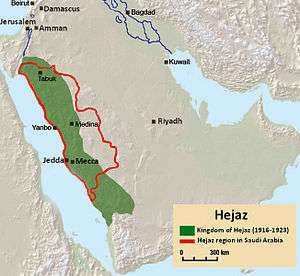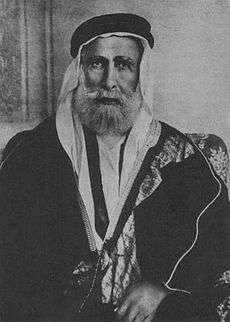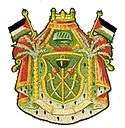Kingdom of Hejaz
| Kingdom of Hejaz | ||||||||||||
| مملكة الحجاز Mamlakat al-Ḥijāz | ||||||||||||
| ||||||||||||
| ||||||||||||
 Kingdom of Hejaz (green) and present Hejaz region (red) on the Arabian Peninsula. | ||||||||||||
| Capital | Mecca | |||||||||||
| Languages | Arabic Ottoman Turkish | |||||||||||
| Religion | Sunni Islam | |||||||||||
| Government | Absolute monarchy | |||||||||||
| King | ||||||||||||
| • | 1916–1924 | Hussein bin Ali | ||||||||||
| • | 1924–1925 | Ali bin Hussein | ||||||||||
| Historical era | Interwar period | |||||||||||
| • | Kingdom established | 10 June 1916 | ||||||||||
| • | Recognized | 10 August 1920 | ||||||||||
| • | Conquered by Nejd | 19 December 1925 | ||||||||||
| • | Ibn Saud crowned King of Hejaz | 8 January 1926 | ||||||||||
| Population | ||||||||||||
| • | 1920 est. | 850,000 | ||||||||||
| ||||||||||||
The Kingdom of Hejaz (Arabic: مملكة الحجاز, Mamlakat al-Ḥijāz) was a state in the Hejaz region in the Middle East that was ruled by the Hashemite dynasty. It achieved national independence after the destruction of the Ottoman Empire by the British Empire during World War I, when the Sharif of Mecca fought in alliance with the British Imperial forces to drive the Turkish Army from the Arabian Peninsula in the Arab Revolt.
The new Kingdom only had a brief life before being conquered in 1925 by the neighbouring Sultanate of Nejd under a resurgent House of Saud, creating the Kingdom of Hejaz and Nejd.[1] On 23 September 1932, the Kingdom of Hejaz and Nejd joined the Saudi dominions of Al-Hasa and Qatif as the unified Kingdom of Saudi Arabia.[2][3]
History

The Sharif of Mecca was an office appointed by the Sultan of the Ottoman Empire in their capacity as Caliph. The role went to a member of the Hashemite family, but the Sultans typically used inter-familial rivalry to pick and choose from among contenders and so ensure that the Sharif remained weak.
With the outbreak of the First World War the Sultan, again in his capacity as Caliph, declared a jihad against the Entente powers and the British, in particular, hoped to co-opt the Sharif as a weighty alternative religious figure backing them in the conflict. The British already had a series of treaties with other Arab leaders in the region and were also fearful that the Hejaz could be used as a base to attack their shipping to and from India. The Sharif was cautious but after discovering that the Ottomans planned to remove him and possibly murder him agreed to work with the British if they would support a wider Arab revolt and the establishment of an independent Arab kingdom. The British implied they would (though were not precise) and, after the Ottomans had executed other Arab nationalist leaders in Damascus and Beirut the Hejaz rose against the Ottomans and soundly defeated their armies, though without completely expelling them (Medina remained under Ottoman control throughout.)
In 1916, the Sharif of Mecca Hussein bin Ali declared himself King of Hejaz as his Sharifian Army participated with other Arab forces and the British Empire in expelling the Turks from the Arabian peninsula.[4][5]
The British though, were compromised by their agreement to give the French control of Syria (a term that includes today's Jordan and Israel and Palestine as well as Lebanon) and did not, in Hussein's eyes, honour their commitments. Nevertheless, they did eventually create Hashemite-ruled kingdoms (in protectorate form) in Jordan and Iraq alongside Hejaz. Hussein thus refused to conclude a treaty of friendship with the British who then later felt powerless to intervene when another British client, Ibn Saud invaded and conquered Hejaz.
Kings of Hejaz
- Hussein bin Ali (10 June 1916 – 3 October 1924)
- Ali bin Hussein (3 October 1924 – 19 December 1925)
See also
References
- ↑ Yamani, Mai (2009), Cradle of Islam : the Hijaz and the quest for an Arabian identity (Pbk. ed.), I.B. Tauris, ISBN 978-1-84511-824-2
- ↑ Madawi Al-Rasheed. A History of Saudi Arabia. Cambridge, England, UK: Cambridge University Press, 2002.
- ↑ A Brief overview of Hejaz - Hejaz history
- ↑ Baker, Randall (1979), King Husain and the Kingdom of Hejaz, Oleander Press, ISBN 978-0-900891-48-9
- ↑ Teitelbaum, Joshua (2001), The rise and fall of the Hashimite Kingdom of Arabia, New York University Press, ISBN 978-0-8147-8271-2

